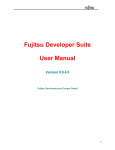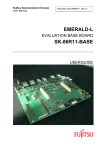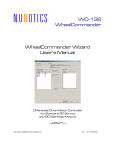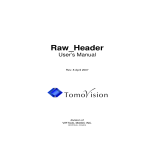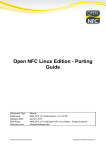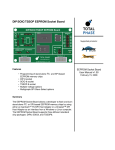Download Fujitsu GDC Studio
Transcript
Fujitsu GDC Studio
Version 1.0.0.0
Fujitsu GDC Studio
Background Information :
z The latest version (described here) is: Version 1.0.0.0
z Extensions to the current preview are in progress
z Changes and / or modifications may occur without prior notice
Fujitsu Microelectronics Europe – http://emea.fujitsu.com/microelectronics
2
Fujitsu GDC Studio Layout
Fujitsu Microelectronics Europe – http://emea.fujitsu.com/microelectronics
3
General Features (1)
Flexible Project File Architecture
z Fujitsu GDC Studio's functionality is configured by loading a chip specific project file
(.gdcproj)
z Project files are currently available for :
• MB88F332 'Indigo'‚
• MB86928 'Ruby'
z Additional project files for future Fujitsu chips are planned
z Project files can also be saved / reloaded when a specific chip status should be recorded
Available Features
z GUI based Register Debugger and Register Sequencer
z GUI based Image Manager and Font Manager
z GUI based memory inspection and editing functions:
• Memory Editor and Hex Dump
• Flash Editor, Flash Dump and Programmer
Fujitsu Microelectronics Europe – http://emea.fujitsu.com/microelectronics
4
General Features (2)
Modular Hardware Abstraction
z Depending on the chip design there are one or more of the following hardware access types
possible :
• SPI – Serial Peripheral Interface (connected via USB)
• PCIe – Peripheral Component Interconnect Express
z Additional interface support is possible but currently not planned
Automatic Installation Setup Wizard available
User Manual with detailed Information available online
Release notes available online
Fujitsu Microelectronics Europe – http://emea.fujitsu.com/microelectronics
5
Register Debugger - Layout
Fujitsu Microelectronics Europe – http://emea.fujitsu.com/microelectronics
6
Register Debugger (1)
Covers the most essential hardware IP‘s of an available design
z e.g. MB88F332 'Indigo‚, MB86928 'Ruby'
Detailed hardware information is visible for the selected ...
z
z
z
z
IP / Component
Address Block
Register
Register Field
Practical register/field reads and writes
z Depending on the register properties, various 'simple to use' controls appear
z The register access type is handled accordingly (R, RW, W, RSVD, ...)
Pop-up descriptions of the selected register fields are displayed
Fujitsu Microelectronics Europe – http://emea.fujitsu.com/microelectronics
7
Register Debugger (2)
Hardware access status supported
z An 'Error' column reporting the status of each access to the corresponding field
is displayed on the far right
z An additional 'Action Reporting Window' can be opened if detailled access information is
needed
Hardware connect / disconnect button available
z Enables a user to use Fujitsu GDC Studio with a different parallel target application
z Prevents hardware access problems if GDC Studio and a separate application use the same
driver interface
z Fujitsu GDC Studio may be disconnected or reconnected at any time
Fujitsu Microelectronics Europe – http://emea.fujitsu.com/microelectronics
8
Register Sequencer – Layout
Fujitsu Microelectronics Europe – http://emea.fujitsu.com/microelectronics
9
Register Sequencer - Debug
Fujitsu Microelectronics Europe – http://emea.fujitsu.com/microelectronics
10
Register Sequencer (1)
Easy creation of register sequences
z Allows a user to define and create new register sequences
z Any of the available register sequences can be selected to get input focus
z The Register Debugger is used to select and add the required registers to the currently active
sequence
z If a special non-listed address (e.g. memory) should be accessed a user defined sequence
element can be inserted allowing to configure access type, size, mode, ...
Register sequence management implemented
z
z
z
z
z
Register sequences can be loaded and saved independently
Sequence names can be created and modified
Individual sequence items can be repositioned or removed
Sequence items can also be deactivated to prevent from execution
Values, Masks, Loop counter, ... of the sequence items can be manipulated
Fujitsu Microelectronics Europe – http://emea.fujitsu.com/microelectronics
11
Register Sequencer (2)
Execution of selected register sequences
z Play and Stop buttons available when connection to the target chip is detected
z Special modes and functions are available, depending on the supported chip
Fujitsu Microelectronics Europe – http://emea.fujitsu.com/microelectronics
12
Register Sequencer (3)
Sequence debugging
z It is also possible to debug register sequences
z For this the following debugging functionality is available :
• Breakpoints
• 'Single Step'
• 'Execute to next Breakpoint'
• 'Stop Sequence'
z Furthermore special sequence items are implemented which support debugging :
• 'Write' register element
• 'Read' register element
• 'Polling Register' elements with a user defined mask and counter
• 'Write Repeat' element
• 'Write Repeat Increment' with an address autoincrement
All Elements above are also available User Defined with a definable address and register size
Fujitsu Microelectronics Europe – http://emea.fujitsu.com/microelectronics
13
Image Manager - Layout
Fujitsu Microelectronics Europe – http://emea.fujitsu.com/microelectronics
14
Image Manager – Pages (1)
Fujitsu Microelectronics Europe – http://emea.fujitsu.com/microelectronics
15
Image Manager – Pages (2)
Fujitsu Microelectronics Europe – http://emea.fujitsu.com/microelectronics
16
Image Manager (1)
Extract image information for application development
z Several pages (tabs) provide functions to extract information from an image file and
to make this available for a target application
z Automatic source ('C') code generation of image information is possible
z 32 bit organized images can also be saved as binary file (.gdc32dat)
z An 'Information Page' is available to obtain general image information
z A 'Pixel Data Page' is available to extract the core pixel values in a specific organization
(8, 16, 24 or 32 bit array)
z A 'Color Palette Page' is available to visualize the colors of indexed format pictures and to
create the corresponding Color-Lookup-Tables (CLUTs)
Conversion of pixel data into a chip-specific structure
z Some chips (e.g. Indigo) require a special pixel data arrangement in memory which
can be created/converted by this tool
Fujitsu Microelectronics Europe – http://emea.fujitsu.com/microelectronics
17
Image Manager (2)
Conversion into different pixel formats
z Images can be read from different image/file formats
z Images can be converted between different pixel formats
Depending on the input image and the pixel format different 'Mask Modes'
will be supported
z
z
z
z
z
Original
Color Only
Alpha Only
Inverted Alpha Only
Alpha + Color
Fujitsu Microelectronics Europe – http://emea.fujitsu.com/microelectronics
18
Image Manager (3)
Support for images of the following file types:
z
z
z
z
z
Bmp
Png
Tiff
Jpeg
Gif
Bitmap
Portable Network Graphics
Tagged Image File Format
Joint Photographic Expert Group
Graphics Interchange Format
Support for the following pixel formats:
z
z
z
z
z
z
1 bpp (bit-per-pixel), indexed
4 bpp, indexed
8 bpp, indexed
16 bpp, different formats
24 bpp, RGB
32 bpp, ARGB
Fujitsu Microelectronics Europe – http://emea.fujitsu.com/microelectronics
19
Image Manager (4)
Support for the following output pixel organization:
z
z
z
z
z
z
z
z
8 Bit
16 Bit
32 Bit
Indigo 32 Bit
Indigo 32 Bit RLD
Ruby 32 Bit ARGB
Ruby 32 Bit ABGR
Ruby 32 Bit RGBA
(Indigo Only)
(Indigo Only)
(Ruby Only)
(Ruby Only)
(Ruby Only)
Any changes are updated immediately in the Picture Box and the
corresponding tab pages
Fujitsu Microelectronics Europe – http://emea.fujitsu.com/microelectronics
20
Font Manager - Layout
Fujitsu Microelectronics Europe – http://emea.fujitsu.com/microelectronics
21
Font Manager (1)
Support for sprite generation during application development
z The Font Manager is used to simply generate attractive letters, numbers or more complex
texts
z The following steps are suggested:
1. Select a system font (and a specific character size)
(if a special font is needed, copy it to the system font directory first!)
2. Select the required text color
3. Choose the destination image background color
4. Select the required rendering mode
5. Save the resulting output image into a 32 bit (ARGB) file
6. Load the stored file into the Image Converter for further processing
All changes made are updated immediately in the Picture Box
Fujitsu Microelectronics Europe – http://emea.fujitsu.com/microelectronics
22
Font Manager (2)
The following rendering modes are supported:
z
z
z
z
z
Anti-aliasing
Anti-aliasing (Grid)
Clear Type (Grid)
Bit Per Pixel
Bit Per Pixel (Grid)
The output image can be saved in one of the following file formats:
z
z
z
z
z
Bmp
Png
Tiff
Jpeg
Gif
Bitmap
Portable Network Graphics
Tagged Image File Format
Joint Photographic Expert Group
Graphics Interchange Format
Fujitsu Microelectronics Europe – http://emea.fujitsu.com/microelectronics
23
Memory Editor - Layout
Fujitsu Microelectronics Europe – http://emea.fujitsu.com/microelectronics
24
Flash Editor - Layout
Fujitsu Microelectronics Europe – http://emea.fujitsu.com/microelectronics
25
Memory / Flash Editor
Useful for several tasks
z Supports debugging and validation for both hardware and software,
e.g. by dumping the memory content to check the proper loading of sprites
z Manipulation of data stored in either RAM or flash memory by:
• reading/writing single memory cells (4 bytes each) or
• reading/writing complete memory blocks from/to a specified address
• Limited to 512 items per block
Using the editor is straightforward:
z Enter the start address (of register, RAM or flash memory)
z Insert the required number of items to be read
(an item is the smallest unit to be dumped = 4 bytes width)
z Read out the memory block into virtual memory by pressing the corresponding button
z Manipulate single items
z Write the manipulated virtual memory block (or parts of it) back to the start
address or any other specified address
Fujitsu Microelectronics Europe – http://emea.fujitsu.com/microelectronics
26
Memory Dump - Layout
Fujitsu Microelectronics Europe – http://emea.fujitsu.com/microelectronics
27
Flash Dump - Layout
Fujitsu Microelectronics Europe – http://emea.fujitsu.com/microelectronics
28
Memory / Flash Dump
Supported Features :
z Provides an overview of large memory blocks, i.e. many more items can be dumped and
listed on the screen than in the Memory Editor
(currently limited to 8MByte)
z Reads register, memory or flash areas
z Saves the dumped data into binary files (.gdc32dat)
z Reloads binary files into the dump view – also converted images
z Loads Register Sequencer files (interpreted as command list values on Indigo)
z Writes the dump view content to a specified address in the register, memory
or flash area
z An internal state machine is implemented to optimize data writing into
flash memory (e.g. check if empty, check for new content before writing,
automatic merges of new data and already existing identical data based on
a read and comparison of corresponding sectors, ...)
Fujitsu Microelectronics Europe – http://emea.fujitsu.com/microelectronics
29
Tool Environment (1)
GDC Studio runs on Microsoft operating systems
z
z
z
z
Windows 2000
Windows XP
Windows Vista (when supported from the interface driver)
GDC Studio's Setup Wizard provides an automatic installation process
Interface between a PC/Laptop and the MB88F332 (Indigo):
SPI
z USB to SPI converter box 'Aardvark I2S/SPI Host Adapter'
z GDC Studio uses the USB driver provided with the 'Aardvark' hardware
z Must be purchased directly from the company 'TOTAL PHASE'
z http://www.totalphase.com/products/aardvark_i2cspi/
z Hardware is not delivered with the tool and is not included in the license fee
Fujitsu Microelectronics Europe – http://emea.fujitsu.com/microelectronics
30
Tool Environment (2)
Interface between a PC/Laptop and the MB86298 (Ruby):
SPI
z USB to SPI converter box 'Aardvark I2S/SPI Host Adapter'
z GDC Studio uses the USB driver provided with the 'Aardvark' hardware
z Must be purchased directly from the company 'TOTAL PHASE'
z http://www.totalphase.com/products/aardvark_i2cspi/
z Hardware is not delivered with the tool and is not included in the license fee
PCIe
z For this chip design the Fujitsu GD Studio supports the PCIe connection of the Ruby
Evaluation Board directly
Fujitsu Microelectronics Europe – http://emea.fujitsu.com/microelectronics
31
Licensing Model
An installation must be licensed for every PC workplace (machine)
Licenses for multiple workplaces (groups) are also possible
A free tool is provided which supports the authorization procedure that
extracts the required information from the PC workplace hardware:
Æ 'Fujitsu GDC Studio Authorization Support Tool'
This information can be selected and sent to Fujitsu GCC to get an
authorization for the use of Fujitsu GDC Studio
The license fee depends on # installations/PC workplaces:
z Licenses are available for groups of:
up to 4 workplaces
up to 6 workplaces
up to 8 workplaces
up to 10 workplaces
up to 12 workplaces
up to 14 workplaces
up to 16 workplaces
Fujitsu Microelectronics Europe – http://emea.fujitsu.com/microelectronics
32
Fujitsu Microelectronics Europe – http://emea.fujitsu.com/microelectronics
33

































